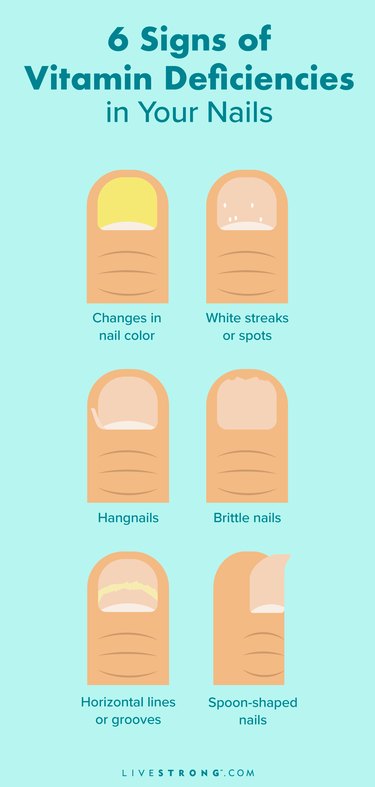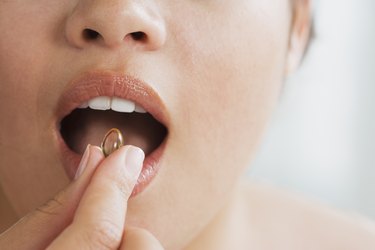
You might be surprised by how much your fingernails can reveal about your health.
Nails are part of your integumentary system, aka, your body's outer layer, which also includes your skin, hair and glands, per the Cleveland Clinic.
Video of the Day
Video of the Day
This system acts as a barrier between the outside world and your internal body, says Brynna Connor, MD, a board-certified family medicine physician and ambassador for NorthWestPharmacy.com.
"As part of our integumentary system, our fingernails are an outward manifestation of our internal health," Dr. Connor says.
All sorts of things can affect your fingernails: Certain diseases, gel manicures, dehydration — plus, simply getting older can lead to changes in your fingernails' appearance, per the National Library of Medicine (NLM). And then there's what you eat and drink.
"Vitamin and mineral deficiencies commonly affect your fingernails," Dr. Connor says.
Why? Well, finger and toenails are made up of a protein called keratin, which your body needs nutrients to produce, and you also need healthy fats and oils from your diet to keep your nails strong and moisturized, per the Cleveland Clinic.
That's why looking at fingernails is often part of a nutritional evaluation, says registered dietitian Kristi Ruth, RD, LDN.
"While several factors can cause changes in the appearance of nails, the potential for a vitamin deficiency or toxicity should be taken into consideration, especially if other causes have been ruled out," Ruth says.
Here, learn about nail changes caused by vitamin deficiencies, other causes of nail changes, tips to care for your nails and when to see a doctor.

1. Changes in Nail Color
A vitamin B12 deficiency can affect the color of your nails, causing them to become bluish or grey-brown in their pigmentation, says Gabriela Czapek, RD, a registered dietitian at CHA Hollywood Presbyterian Medical Center.
B12 is an essential vitamin that helps keep the cells in your body healthy and makes DNA, per the National Institutes of Health (NIH).
Because foods high in B12 include beef, seafood and dairy products, vegans and vegetarians are at higher risk for B12 deficiency (although you can get it in some fortified foods like breakfast cereals and nutritional yeast). Older adults and people with certain health conditions might also have difficulty getting enough of this vitamin, per the NIH.
Other symptoms of low B12 include:
- Fatigue
- Dizziness or shortness of breath
- Rapid heart rate
- Pale or yellow skin
- Numbness or tingling in the fingers or toes
- Confusion or trouble focusing
- Swollen or sore tongue
Other Causes of Nail Color Changes
These conditions can also cause changes to the color of your nails, according to the American Academy of Dermatology (AAD):
- White nails: Diabetes or liver disease
- Yellow nails: Lung disease or a nail infection
- Dusky red half-moons: Lupus, heart disease, alopecia areata (which also causes hair loss), arthritis or dermatomyositis (a rare inflammatory disease marked by muscle weakness and a skin rash)
- Half pink, half white nails: Kidney disease
- Blue nails: Not enough oxygen in your bloodstream
- Dark streak: Melanoma (skin cancer)
"There's also a condition called Terry's nails, where most of the nail is white except for a pink band at the tip, which can be due to liver disease, congestive heart failure, aging and other conditions," Dr. Connor adds.
2. White Streaks or Lines
While white spots on your nails are most likely due to an external cause, such as trauma to the nail (think: nail biting, rough manicures) or a reaction to nail polish, white lines or streaks may be due to a vitamin deficiency.
More specifically, these white lines or ridges may be due to deficiencies in zinc, calcium or B-complex vitamins, according to a March-April 2015 review in the Indian Dermatology Online Journal.
Zinc-rich foods include meats like beef, turkey and pork as well as tofu, lentils and chickpeas.
Dairy products are the most well-known foods high in calcium, but some beans and seeds are decent sources, too.
And foods high in vitamin B include salmon, spinach, brown rice and lentils.
All-white or mostly white nails could be due to a selenium deficiency, per the same review in the Indian Dermatology Online Journal. Selenium-rich foods include many nuts and seeds as well as many types of seafood and meats like chicken, turkey and pork.
Other Causes of White Spots or Streaks
Most white streaks or spots do not indicate serious health issues, per the Cleveland Clinic, but they can sometimes be caused by:
- Fungal infections, which would also cause them to look thick or cracked
- Certain medications, such as those used to treat bacterial infections or urinary tract infections
- Rarely, systemic diseases, including psoriasis, diabetes, heart failure, HIV and liver cirrhosis
3. Hangnails
"Low vitamin C and low folic acid can cause nail integrity loss, resulting in an increased frequency of hangnails," Dr. Connor says.
Foods rich in vitamin C include many fruits and vegetables, including red bell peppers, kiwi, strawberries, broccoli and guava.
Fruits and veggies are also the best source of folic acid, or folate.
Other Causes of Hangnails
You can also get hangnails from picking at the skin on the sides of your fingernails, causing the skin to tear and, in severe cases, bleed or get infected, per the Cleveland Clinic.
4. Brittle or Cracked Nails
Several vitamin and mineral deficiencies can cause brittle nails. Some of the more common include iron, biotin and calcium.
"One of the most common signs of iron-deficiency anemia is brittle or spoon-shaped nails," Ruth says.
Before you even get a blood test and find out you're iron-deficient, one of the first signs might be dry or brittle nails. If that's the case, try to incorporate more foods high in iron in your diet, like spinach, kidney beans or fortified cereals.
"A biotin deficiency could also leave nails brittle and prone to breaking," says Amanda Lane, RD, CDCES, a registered dietitian and founder of Healthful Lane Nutrition.
It's important to keep in mind that while brittle nails can be a sign of a deficiency, there's not much evidence that taking biotin when you don't have a deficiency will improve your nails, per the AAD.
It's also rare to fall short on biotin, per the NIH. In fact, there are many foods rich in biotin like egg yolks, salmon and sweet potato.
Additionally, "low calcium levels can cause cause dry, brittle nails, too," Dr. Connor says. Dairy products are a great source of this nutrient, but other foods high in calcium are sardines (with the bones), beans and seeds.
Other Causes of Brittle Nails
According to the Cleveland Clinic, brittle nails can result from:
- Frequent hand-washing or saniziting
- Aging
- Nail cosmetic products (the acetone used to remove manicures can lead to brittle nails, as can picking off the polish, Ruth says)
- Chemotherapy
And less commonly:
- Fungal infections, which also cause nails to thicken and turn yellow
- Psoriasis
- Thyroid disorders
- Raynaud's syndrome
Tip
If your fingernails are brittle but your toenails are strong, then the culprit is likely an external factor (not a nutrient deficiency), per the American Osteopathic College of Dermatology (AOCD).
5. Horizontal Lines or Grooves
Horizontal ridges or Beau's lines are on the surface of your nails rather than inside your nails, and can occur because of a lack of zinc, per the Mayo Clinic.
Indeed, a zinc deficiency could look like, "depressions across the fingernails," Ruth says.
To get more zinc, try eating foods high in zinc like oysters, beef or tofu, or taking a zinc supplement.
Another type of horizontal line that can appear on your nails is called Muehrcke's lines. These are parallel, horizontal white lines that extend across your nails, and are often a sign of low protein levels in your blood, per the NLM.
Other Causes of Horizontal Lines
Other causes of Beau's lines include the following, per the Mayo Clinic:
- Infections
- Illnesses that cause a high fever (measles, mumps, scarlet fever)
- Diabetes that isn't well-managed
- Peripheral artery disease
- Certain medications, including retinoids and chemotherapy
Muehrcke's lines can also happen from health problems like liver disease, per the NLM.
Chronic stress can also be a result of horizontal lines on your nails. But fortunately, these lines will go away after a period of time. You just have to allow your nails to grow out, per the Cleveland Clinic.
6. Flattened or Spoon-Shaped Nails (Koilonychia)
Also known as spoon-shaped nails, koilonychia can look like your nails "are scooped out," Dr. Connor says. This is often due to an iron deficiency or a lack of vitamin C, per the NLM.
(If your nails have a flattened appearance, this may be the first sign of koilonychia. After a while, the indentation will begin to form and the nails will take on a spoon shape, per the Cleveland Clinic.)
With koilonychia, the nails are soft and turned up at the edges.
Talk to your doctor about treating an iron deficiency — they may suggest eating more foods high in iron, like meats, and possibly taking iron supplements or getting iron infusions as well.
You may also need to address underlying health conditions that cause poor iron absorption, per the AAD, such as celiac disease.
You can also try eating more foods high in vitamin C, like red bell peppers, broccoli or strawberries. Taking vitamin C tablets could also aid in iron absorption, which can help not only your nails, but your overall health, per ConsumerLab.
Other Causes of Spoon-Shaped Nails
Spoon nails could also be due to a liver problem called hemochromatosis, which causes the body to absorb too much iron from food, per the Mayo Clinic.
Nail Changes Caused by Other Things
Nail changes aren't only caused by vitamin or mineral deficiencies. Sometimes a health condition may be to blame, or even certain lifestyle factors.
1. Nail Clubbing
Nail clubbing is when the tips of the fingers get bigger and the nails curve downward over the fingertips.
This condition causes your nails to look like upside-down spoons and feel soft or sponge-like, per the Cleveland Clinic.
Some common causes of nail clubbing include the following, per the Cleveland Clinic:
- A family history of nail clubbing
- Heart and lung conditions, such as heart disease, cystic fibrosis and interstitial lung disease
- Digestive or malabsorption conditions such as Crohn's disease, celiac disease and other conditions that cause inflammation in your GI tract
- Cirrhosis, also known as liver disease
- Certain cancers, such as lung cancer, esophageal cancer, Hodgkin lymphoma and rhabdomyosarcoma (i.e., cancer of soft tissue)
- Certain thyroid conditions, such as hyperthyroidism (overactive thyroid) and Grave's disease
Your nails should slowly return to normal once you treat the underlying condition that's causing this change, per the Cleveland Clinic.
2. Pitted Nails
Nails with small pits or dents that look like they were made by an icepick may be caused by the following, per the AAD and Mayo Clinic:
- Psoriasis or psoriatic arthritis
- Eczema
- Alopecia areata
3. Washboard Nails
If you have lines in your fingernails that are neither white nor complete horizontal ridges, you may have washboard nails. These are nails with thin, darkened grooves or horizontal ridges that happen when your cuticle is frequently picked at or pushed back, per the AAD.
These ridges are unrelated to nutritional deficiencies and other illnesses, and they can easily go away as long as your cuticle isn't repeatedly removed or damaged, per the AAD.
4. Vertical Lines
Vertical ridges or streaks in your nails can be normal — especially as you get older — but they can also develop if you have a skin condition like eczema or if you have hypothyroidism (i.e., underactive thyroid), per the Cleveland Clinic.
Rarely, tumors in the tissue around the nails can also cause changes in nail texture, according to Merck Manuals.
Vertical dark brown, black or gray streaks, especially running from tip to cuticle, are called longitudinal melanonychia. They can be from dilated or burst capillaries, injury, bacterial or fungal infection or excess melanin in the nail beds, per a May 2016 review in the Cleveland Clinic Journal of Medicine.
But if you haven't recently hurt your finger or toe, these lines may be unrelated to blood-flow issues, and instead, a sign of melanoma (skin cancer).
Unlike other types of melanoma, this type — known as acral lentiginous melanoma (ALM) — isn't related to sun exposure. This melanoma is pretty rare, and treatment includes surgery to remove the cancer, per the Memorial Sloan Kettering Cancer Center.
5. Thicker Nails
One common cause of thickened nails is a fungal infection, per the Mayo Clinic. It can begin as a white or yellow-brown spot under your nail, and then cause the entire nail to become dry and brittle. It may also cause your nails to become misshapen or separated from the nail bed.
Thickened nails may also be due to a wart that's formed in this area, per Mount Sinai.
Aging can also lead to thicker nails. As you age, your nails may become more thick and opaque rather than translucent. They may also develop a yellowish tint to them, and split at the top. This is a normal part of the aging process for most people, per the NLM.
Tips to Care for Your Nails
Giving your nails a little TLC will help them look their best — and also ensure you're familiar with their typical appearance, so you'll catch any changes early on.
Try these strategies to keep your nails healthy and well cared for:
- Clip and trim them as needed, and use sharp clippers or nail scissors, per the Mayo Clinic. Do not bite your nails or pick at hangnails.
- Keep them moisturized and protected: Nails become brittle and dry when they go from wet to dry several times a day, according to the AOCD. Of course, that's inevitable if you wash your hands frequently or you spend a lot of time doing dishes or house cleaning. But you can prevent excessive time in water by wearing gloves as you do the dishes. Apply lotion after your hands have been in water to keep the nails and nail beds moisturized. It's also a good idea to wear gloves when using cleaning fluids and detergents, which can be hard on nails.
- Buff nails vertically, not horizontally: Going back and forth across your nail can lead to nail splitting, according to the AOCD.
- Opt for acetone-free nail polish remover, per the Mayo Clinic.
When to See a Doctor About Nail Changes
Sure, we all want to avoid brittle, misshapen or discolored nails. But it's more than a matter of aesthetics: Changes in the appearance of nails can point to nutritional deficiencies or other serious health conditions. This is especially relevant if you have other symptoms with nail changes, because vitamin or mineral deficiencies can affect multiple parts of the body.
Talking to your doctor or a dermatologist is a great first step whenever you notice any nail changes.
"Your physician can help you figure out where the problem is so that you can correct it," Dr. Connor says, noting that it's important to get to the root cause behind the shift in appearance.
- Cleveland Clinic: "Integumentary System"
- National Library of Medicine: "Aging changes in nails"
- Office of Dietary Supplements: "Vitamin B12"
- Indian Dermatology Online Journal: "Reversible Melanonychia Revealing Nutritional Vitamin-B12 Deficiency"
- Dermatology World Insights and Inquiries: "BIOTIN SUPPLEMENTATION FOR HAIR AND NAIL HEALTH: DOES IT PASS THE TEST?"
- Cleveland Clinic: "Biotin Benefits: What the Experts Have to Say"
- Indian Dermatology Online Journal: "Nail as a window of systemic diseases"
- ConsumerLab: "Vitamin C Supplements Review'
- Mayo Clinic: "Fingernails: Do's and don'ts for healthy nails"
- American Osteopathic College of Dermatology: "BRITTLE SPLITTING NAILS"
- Cleveland Clinic: "Keratin"
- Tropical Doctor: "Diffuse Melanonychia as a Clue to Vitamin B12 Deficiency"
- Healthfullane.com: "Amanda Lane, RD"
- Cleveland Clinic: "White Spots on Nails (Leukonychia)"
- NLM: "Muehrcke Lines of the Fingernails"
- Mayo Clinic: "7 Fingernail Problems Not to Ignore"
- Cleveland Clinic: "6 Things Your Nails Say About Your Health"
- American Academy of Dermatology: "12 NAIL CHANGES A DERMATOLOGIST SHOULD EXAMINE"
- NLM: "Spoon Nails"
- Cleveland Clinic: "Ridges in Nails"
- Cleveland Clinic Journal of Medicine: "Evaluation of nail lines: Color and shape hold clues"
- Memorial Sloan Kettering Cancer Center: "Acral Lentiginous Melanoma"
- Cleveland Clinic: "How to Get Rid of Hangnails"
- Mayo Clinic: "Nail Fungus"
- Cleveland Clinic: "Nail Clubbing"
- Cleveland Clinic: "Brittle Nails: Causes and Treatment Tips"
- Mount Sinai: "Warts Information"
- Merck Manuals: "Tumors of the Nails: Skin Disorders"


